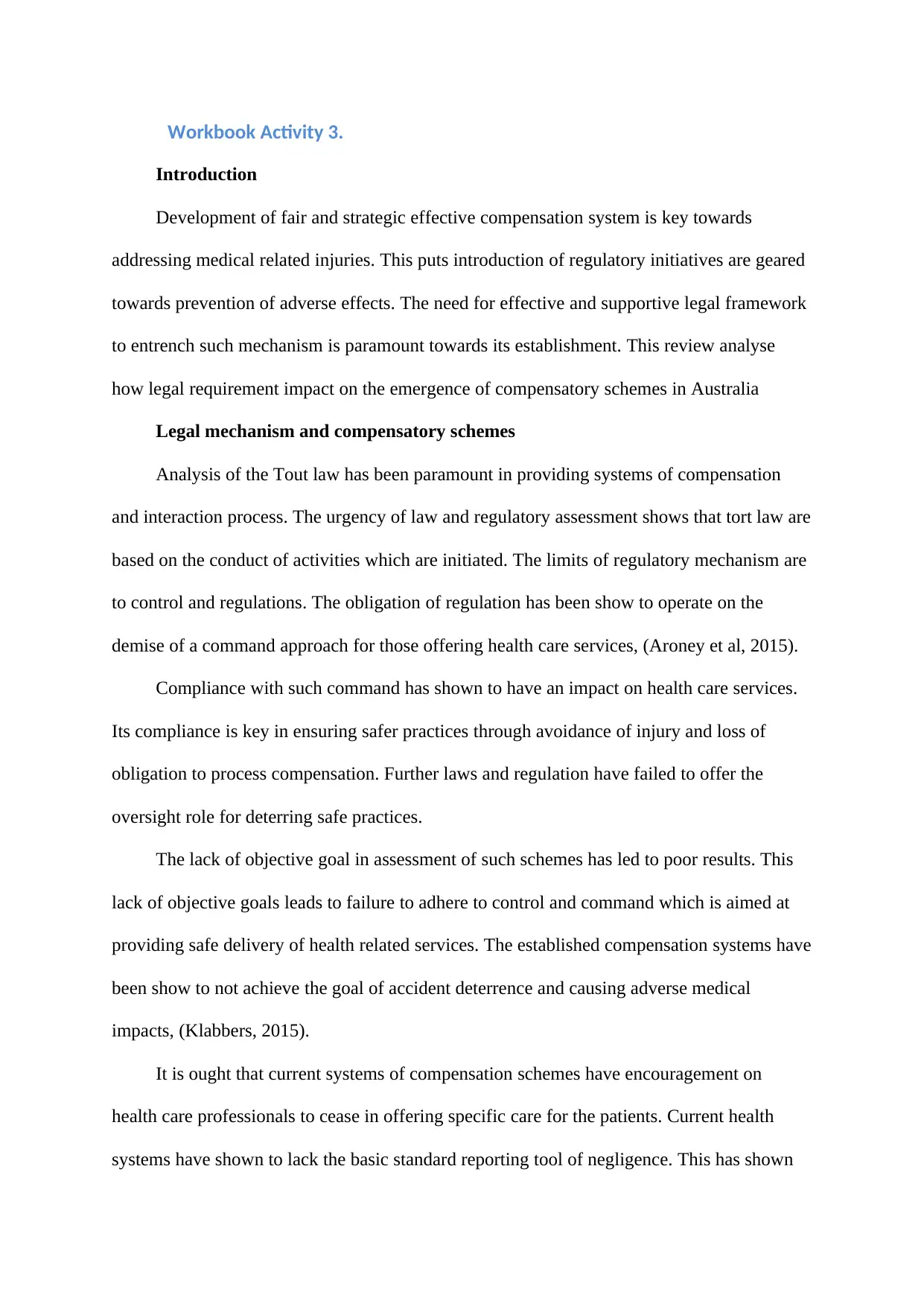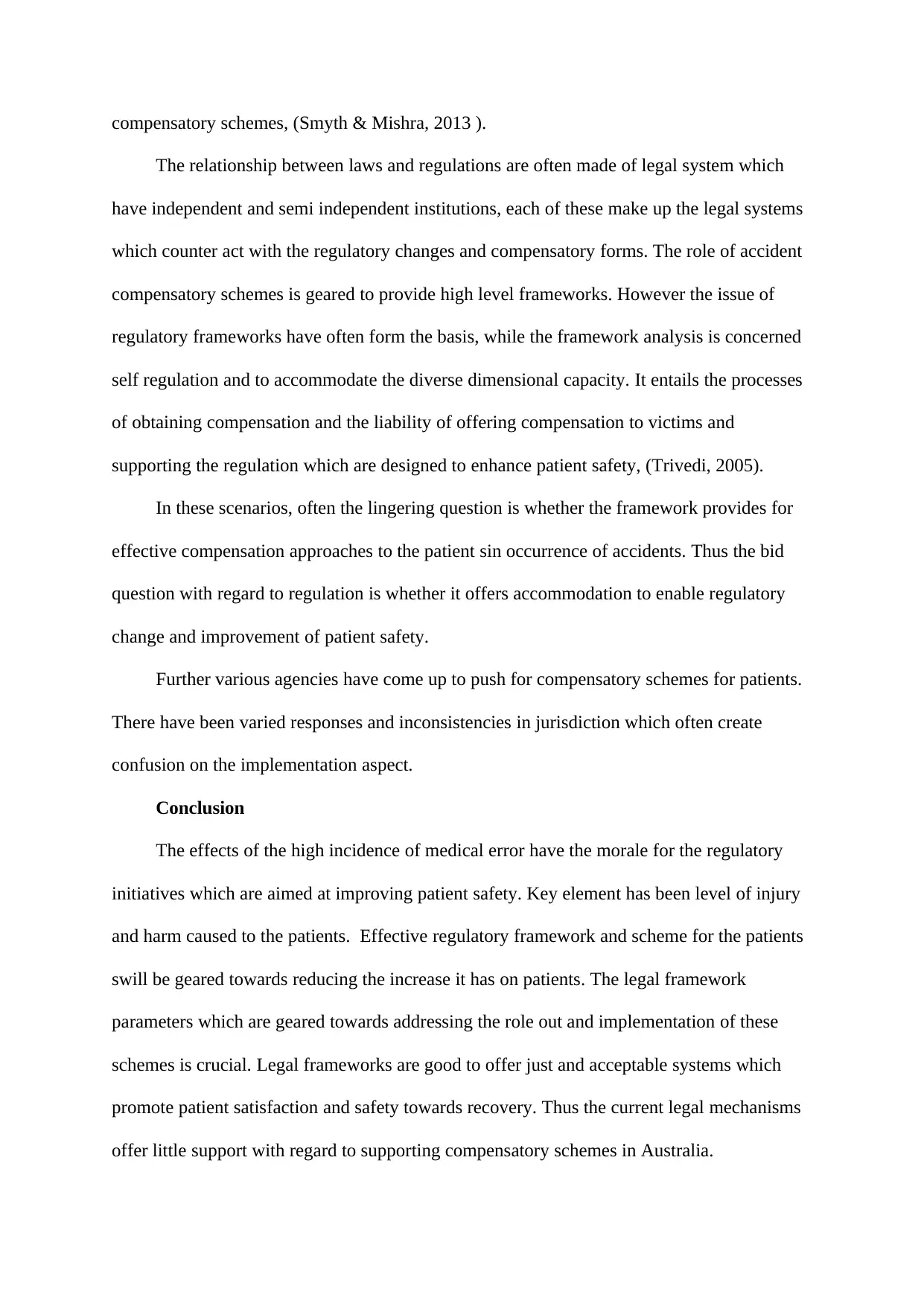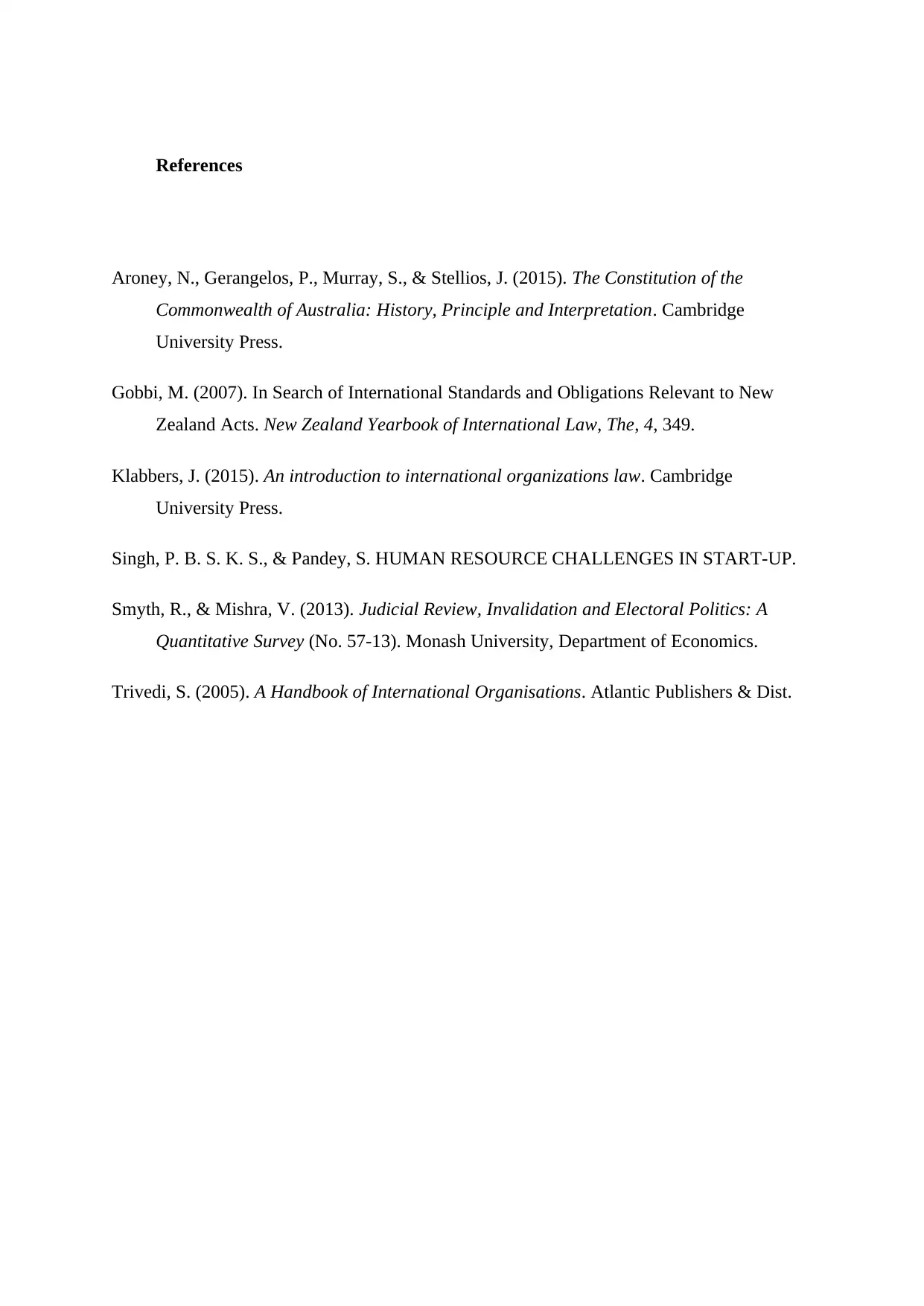PUN214: Legal Mechanisms as Barriers to Patient Safety & Quality
VerifiedAdded on 2023/06/14
|4
|1134
|357
Essay
AI Summary
This essay examines the influence of legal mechanisms on patient safety and quality within the Australian healthcare system, particularly in the context of the PUN214 Systems of Quality and Safety in Health Care module. It analyses how tort law and regulatory initiatives impact the development of compensatory schemes for medical injuries, highlighting the limitations of current regulatory mechanisms in deterring unsafe practices and achieving accident deterrence. The essay discusses the role of legal frameworks in offering analysis and revealing indirect connections between regulation and policy outcomes, emphasizing the need for fair and effective systems that align with policy goals and compensatory schemes. It also addresses the proliferation of guidelines and laws, the importance of compliance, and the debate surrounding regulatory frameworks among various institutions, laws, practices, and cultures. The conclusion underscores the importance of effective regulatory frameworks in improving patient safety, reducing harm, and promoting patient satisfaction and recovery, while noting the limited support offered by current legal mechanisms for compensatory schemes in Australia.

Workbook Activity 3.
Introduction
Development of fair and strategic effective compensation system is key towards
addressing medical related injuries. This puts introduction of regulatory initiatives are geared
towards prevention of adverse effects. The need for effective and supportive legal framework
to entrench such mechanism is paramount towards its establishment. This review analyse
how legal requirement impact on the emergence of compensatory schemes in Australia
Legal mechanism and compensatory schemes
Analysis of the Tout law has been paramount in providing systems of compensation
and interaction process. The urgency of law and regulatory assessment shows that tort law are
based on the conduct of activities which are initiated. The limits of regulatory mechanism are
to control and regulations. The obligation of regulation has been show to operate on the
demise of a command approach for those offering health care services, (Aroney et al, 2015).
Compliance with such command has shown to have an impact on health care services.
Its compliance is key in ensuring safer practices through avoidance of injury and loss of
obligation to process compensation. Further laws and regulation have failed to offer the
oversight role for deterring safe practices.
The lack of objective goal in assessment of such schemes has led to poor results. This
lack of objective goals leads to failure to adhere to control and command which is aimed at
providing safe delivery of health related services. The established compensation systems have
been show to not achieve the goal of accident deterrence and causing adverse medical
impacts, (Klabbers, 2015).
It is ought that current systems of compensation schemes have encouragement on
health care professionals to cease in offering specific care for the patients. Current health
systems have shown to lack the basic standard reporting tool of negligence. This has shown
Introduction
Development of fair and strategic effective compensation system is key towards
addressing medical related injuries. This puts introduction of regulatory initiatives are geared
towards prevention of adverse effects. The need for effective and supportive legal framework
to entrench such mechanism is paramount towards its establishment. This review analyse
how legal requirement impact on the emergence of compensatory schemes in Australia
Legal mechanism and compensatory schemes
Analysis of the Tout law has been paramount in providing systems of compensation
and interaction process. The urgency of law and regulatory assessment shows that tort law are
based on the conduct of activities which are initiated. The limits of regulatory mechanism are
to control and regulations. The obligation of regulation has been show to operate on the
demise of a command approach for those offering health care services, (Aroney et al, 2015).
Compliance with such command has shown to have an impact on health care services.
Its compliance is key in ensuring safer practices through avoidance of injury and loss of
obligation to process compensation. Further laws and regulation have failed to offer the
oversight role for deterring safe practices.
The lack of objective goal in assessment of such schemes has led to poor results. This
lack of objective goals leads to failure to adhere to control and command which is aimed at
providing safe delivery of health related services. The established compensation systems have
been show to not achieve the goal of accident deterrence and causing adverse medical
impacts, (Klabbers, 2015).
It is ought that current systems of compensation schemes have encouragement on
health care professionals to cease in offering specific care for the patients. Current health
systems have shown to lack the basic standard reporting tool of negligence. This has shown
Paraphrase This Document
Need a fresh take? Get an instant paraphrase of this document with our AI Paraphraser

that it makes it more difficult for health care practitioners to engage actively in such process
of regulation which are geared for effective systems which are able to lead to systematic
responsibility in relation to harm.
The crucial role which regulation frameworks provides is to offer analysis and to reveal
on the basic understanding of the indirect confections which are linked between regulation
and policy outcome initiatives through the broader systems of regulation. The inbuilt indirect
relationships between systems of compensation and regulation have seen the insight of
designing fair and effective systems which enable and initiate achievement of policy
regulation and goals of compensatory schemes, (Gobbi, 2007).
The claims which are predominant on the new regulatory state have been observed.
These claims at times have been on grounds through which the law as a component of legal
system. However there has been change on how we come to understand how regulation
works in the current society. There has been increased proliferation of guidelines and laws
which guide the compensatory agencies.
The broader understanding of these habits and trends, this entails the influential events
which are very crucial in ensuring compliance on the directions being regulated. With respect
with existing compensation mechanism, there is need to have a better command of achieving
the public policy goals in accident compensation schemes.
Regulation of this level has provided a complex forms which are integrated into new
systems aimed at achieving patient outcome gaols. Regulation is underpinned to creation of
system which utilises system capacity outcomes, (Sigh & Pandey, n.d).
There is big debate on the role and design f regulatory frameworks among different
institutions, laws and practices and cultures which offer interaction of the space available.
Interaction of institutions entails laws, practices and cultures. This interaction is geared at
building greater interaction of and accommodating change which ensures effectiveness of
of regulation which are geared for effective systems which are able to lead to systematic
responsibility in relation to harm.
The crucial role which regulation frameworks provides is to offer analysis and to reveal
on the basic understanding of the indirect confections which are linked between regulation
and policy outcome initiatives through the broader systems of regulation. The inbuilt indirect
relationships between systems of compensation and regulation have seen the insight of
designing fair and effective systems which enable and initiate achievement of policy
regulation and goals of compensatory schemes, (Gobbi, 2007).
The claims which are predominant on the new regulatory state have been observed.
These claims at times have been on grounds through which the law as a component of legal
system. However there has been change on how we come to understand how regulation
works in the current society. There has been increased proliferation of guidelines and laws
which guide the compensatory agencies.
The broader understanding of these habits and trends, this entails the influential events
which are very crucial in ensuring compliance on the directions being regulated. With respect
with existing compensation mechanism, there is need to have a better command of achieving
the public policy goals in accident compensation schemes.
Regulation of this level has provided a complex forms which are integrated into new
systems aimed at achieving patient outcome gaols. Regulation is underpinned to creation of
system which utilises system capacity outcomes, (Sigh & Pandey, n.d).
There is big debate on the role and design f regulatory frameworks among different
institutions, laws and practices and cultures which offer interaction of the space available.
Interaction of institutions entails laws, practices and cultures. This interaction is geared at
building greater interaction of and accommodating change which ensures effectiveness of

compensatory schemes, (Smyth & Mishra, 2013 ).
The relationship between laws and regulations are often made of legal system which
have independent and semi independent institutions, each of these make up the legal systems
which counter act with the regulatory changes and compensatory forms. The role of accident
compensatory schemes is geared to provide high level frameworks. However the issue of
regulatory frameworks have often form the basis, while the framework analysis is concerned
self regulation and to accommodate the diverse dimensional capacity. It entails the processes
of obtaining compensation and the liability of offering compensation to victims and
supporting the regulation which are designed to enhance patient safety, (Trivedi, 2005).
In these scenarios, often the lingering question is whether the framework provides for
effective compensation approaches to the patient sin occurrence of accidents. Thus the bid
question with regard to regulation is whether it offers accommodation to enable regulatory
change and improvement of patient safety.
Further various agencies have come up to push for compensatory schemes for patients.
There have been varied responses and inconsistencies in jurisdiction which often create
confusion on the implementation aspect.
Conclusion
The effects of the high incidence of medical error have the morale for the regulatory
initiatives which are aimed at improving patient safety. Key element has been level of injury
and harm caused to the patients. Effective regulatory framework and scheme for the patients
swill be geared towards reducing the increase it has on patients. The legal framework
parameters which are geared towards addressing the role out and implementation of these
schemes is crucial. Legal frameworks are good to offer just and acceptable systems which
promote patient satisfaction and safety towards recovery. Thus the current legal mechanisms
offer little support with regard to supporting compensatory schemes in Australia.
The relationship between laws and regulations are often made of legal system which
have independent and semi independent institutions, each of these make up the legal systems
which counter act with the regulatory changes and compensatory forms. The role of accident
compensatory schemes is geared to provide high level frameworks. However the issue of
regulatory frameworks have often form the basis, while the framework analysis is concerned
self regulation and to accommodate the diverse dimensional capacity. It entails the processes
of obtaining compensation and the liability of offering compensation to victims and
supporting the regulation which are designed to enhance patient safety, (Trivedi, 2005).
In these scenarios, often the lingering question is whether the framework provides for
effective compensation approaches to the patient sin occurrence of accidents. Thus the bid
question with regard to regulation is whether it offers accommodation to enable regulatory
change and improvement of patient safety.
Further various agencies have come up to push for compensatory schemes for patients.
There have been varied responses and inconsistencies in jurisdiction which often create
confusion on the implementation aspect.
Conclusion
The effects of the high incidence of medical error have the morale for the regulatory
initiatives which are aimed at improving patient safety. Key element has been level of injury
and harm caused to the patients. Effective regulatory framework and scheme for the patients
swill be geared towards reducing the increase it has on patients. The legal framework
parameters which are geared towards addressing the role out and implementation of these
schemes is crucial. Legal frameworks are good to offer just and acceptable systems which
promote patient satisfaction and safety towards recovery. Thus the current legal mechanisms
offer little support with regard to supporting compensatory schemes in Australia.
⊘ This is a preview!⊘
Do you want full access?
Subscribe today to unlock all pages.

Trusted by 1+ million students worldwide

References
Aroney, N., Gerangelos, P., Murray, S., & Stellios, J. (2015). The Constitution of the
Commonwealth of Australia: History, Principle and Interpretation. Cambridge
University Press.
Gobbi, M. (2007). In Search of International Standards and Obligations Relevant to New
Zealand Acts. New Zealand Yearbook of International Law, The, 4, 349.
Klabbers, J. (2015). An introduction to international organizations law. Cambridge
University Press.
Singh, P. B. S. K. S., & Pandey, S. HUMAN RESOURCE CHALLENGES IN START-UP.
Smyth, R., & Mishra, V. (2013). Judicial Review, Invalidation and Electoral Politics: A
Quantitative Survey (No. 57-13). Monash University, Department of Economics.
Trivedi, S. (2005). A Handbook of International Organisations. Atlantic Publishers & Dist.
Aroney, N., Gerangelos, P., Murray, S., & Stellios, J. (2015). The Constitution of the
Commonwealth of Australia: History, Principle and Interpretation. Cambridge
University Press.
Gobbi, M. (2007). In Search of International Standards and Obligations Relevant to New
Zealand Acts. New Zealand Yearbook of International Law, The, 4, 349.
Klabbers, J. (2015). An introduction to international organizations law. Cambridge
University Press.
Singh, P. B. S. K. S., & Pandey, S. HUMAN RESOURCE CHALLENGES IN START-UP.
Smyth, R., & Mishra, V. (2013). Judicial Review, Invalidation and Electoral Politics: A
Quantitative Survey (No. 57-13). Monash University, Department of Economics.
Trivedi, S. (2005). A Handbook of International Organisations. Atlantic Publishers & Dist.
1 out of 4
Related Documents
Your All-in-One AI-Powered Toolkit for Academic Success.
+13062052269
info@desklib.com
Available 24*7 on WhatsApp / Email
![[object Object]](/_next/static/media/star-bottom.7253800d.svg)
Unlock your academic potential
Copyright © 2020–2025 A2Z Services. All Rights Reserved. Developed and managed by ZUCOL.





